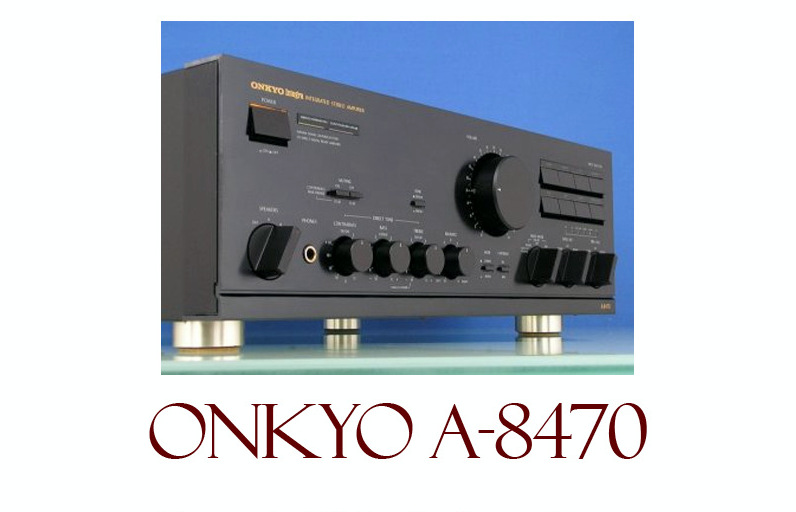Onkyo A-8470
Data
General
- Manufacturer: Onkyo
- Model: A-8470 - Onkyo Integra Series
- Type: Integrated amplifier
- Years of manufacture: 1987 - 1988
- Made in: Japan
- Colours: Silver, Black
- Remote control: No
- Power consumption: 360 W
- Dimensions: 435 x 157 x 396 mm (WxHxD)
- Weight: 13.2 kg
- Original price approx.: 1'000 DM
Connections
- Number of inputs: 6
- Phono (MM/MC)
- Tuner
- CD
- 2x Aux (VCR and VDP)
- 2x Tape
- Number of outputs: 3
- Headphones (6,3 mm jack)
- 2x Tape Rec.
- 2x loudspeaker
Technical Data
- Continuous power (at distortion factor)
- 8 Ohm: 115 W / 1 kHz
- 4 Ohm: 150 W / 1 kHz
- Dynamic power
- 8 Ohm: 170 W
- 4 Ohm: 235 W
- 2 Ohm: 303 W
- Total harmonic distortion: 0.008%
- Intermodulation distortion: 0.005% at rated power
- Attenuation factor: 50 (at 8 ohms)
- Input (Sensitivity/ Impedance)
- Phono (MM): 2.5 mV / 50 kOhm (94dB at 5.0 mV input), (MC): 160 µV / 220 kOhm (75dB at 0.6 mV input)
- Tuner, CD, CD Direct, Aux, Tape = 150 mV / 50 kOhm (CD Direct: 107 dB)
- Frequency response CD & Tuner: 2 - 50,000 Hz (-0, -1 dB)
- Frequency response Phono (MM): 20 - 20,000 Hz (+/- 0.3dB)
- Tone control:
- Double bass: +/-10 dB Mute OFF / +/-20 dB Mute ON (at 20 Hz).
- Bass: +/-10 dB (at 70 Hz)
- Treble: +/-8 dB (at 20 kHz)
- Loudness: No
- Subsonic: no
- Mute: yes (-20 dB)
- CD-Direct/Line-Straight: yes
Special Features
- REAL-PHASE system = exactly the same phase position of both stereo signals for perfect sound purity and original fidelity of a digital music recording
- Switch-on delay via relay
- Switching off the power amplifier in case of speaker overload
- The position settings of the direct selection switches (switched) are backlit
Remarks
- Other models in the same series:
- Onkyo A-8420
- Onkyo A-8430
- Onkyo A-8450
- Onkyo A-8470
Pictures
- [[Picture: Onkyo A-8470
Reports
- On one bought used (07/2012) everything runs great, only the volume control grates a bit. Rich and clean performance, with CD Direct possibly a little little bass (subjective) but that can be compensated via bass and double bass (no longer CD Direct).
Even (m)a used amplifier acquired in the late 90s has always run smoothly and completely reliably (this is probably also a result of the fact that he never had to wait in a [damp] storeroom / cellar). For purists, an all-around great (real) analog amplifier without any A/D converters and servo drives (remote control). Otherwise, very cleanly processed and even after more than 20 years old optics as good as new!
